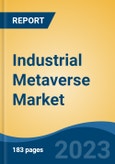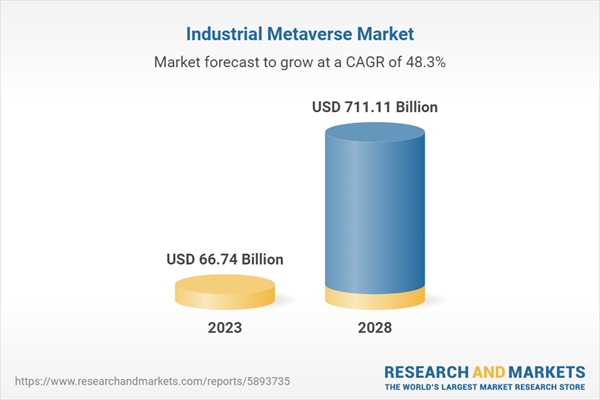Speak directly to the analyst to clarify any post sales queries you may have.
10% Free customizationThis report comes with 10% free customization, enabling you to add data that meets your specific business needs.
The industrial metaverse combines the digital and physical worlds to increase efficiency in engineering, production, and field service. Although it is currently in its early phases, the goal is to provide real-time collaboration, networking, and spatially aware context in industrial situations. In other words, it is a particular implementation of the metaverse idea in the manufacturing, building, and engineering fields. Engineers, designers, and other stakeholders will be able to work together in real-time in the industrial metaverse regardless of where they are physically.
Global Industrial Metaverse Market: Drivers & Trends
Increasing Role of Internet of Things in the Industrial Metaverse:
IoT plays a significant role in the development of the industrial metaverse. It provides real-time data on the performance of machines, equipment and processes. IoT devices can be integrated into a wide range of industrial equipment, such as sensors that monitor temperature, pressure, and vibration.IoT devices gather real-time data from various sources, such as sensors and machines, and send it to a digital twin model for analysis and simulation. By using IoT sensors to collect data from physical objects in the real world, digital twin models can create a virtual replica of the physical object. This allows for better monitoring, optimization, and analysis of industrial processes.
In the industrial metaverse, digital twins can be connected through IoT networks, creating a comprehensive digital ecosystem. This interconnection allows for seamless communication between various digital twins and real-world devices, enabling a more comprehensive view of the entire industrial process.
IoT provides the real-world data necessary for digital twin models to accurately simulate and optimize industrial processes, making it a critical component of the industrial metaverse. By leveraging IoT technology, the manufacturing industry can improve efficiency, reduce costs and increase competitiveness in the global industrial metaverse market.
Increasing Applications of Digital Twin Technology in Industrial Metaverse:
The industrial metaverse is the fusion of the digital and physical realms, where people, machines, data, and processes are seamlessly linked and communicate real-time across virtual and actual locations. Digital twins serve as a dynamic substitute for actual systems, procedures, and assets in the industrial metaverse.The concept of digital twins in the industrial metaverse refers to creating virtual replicas of physical assets, systems, or processes in the virtual world. These digital twins can be leveraged in various ways to enhance industrial operations and decision-making. For instance, one of the major applications of digital twins in industrial metaverse is predictive maintenance in which digital twins can simulate the behaviour of physical assets in real-time, enabling predictive maintenance. By monitoring and analysing data from the virtual twin, it becomes possible to identify potential issues or failures before they occur in the physical world. This helps in optimizing and maintaining schedules, reducing downtime, and increase lifespan of assets.
Similarly, digital twins in industrial metaverse are used for process optimization where industrial processes can be complex and expensive to modify or optimize in the physical world. By creating digital twins, companies can experiment with different scenarios, test process changes, and identify the most efficient configurations. It allows for continuous process improvement, cost reduction, and enhanced productivity.
Hence, with the growing applications of digital twins in Industrial metaverse, the market is predicted to expand during the forecast period.
Emergence of 5G Technology Creating Lucrative Industrial Metaverse Market:
The development of the industrial metaverse is being made easier by the arrival of 5G technology. Real-time data and digital representations of actual items are combined to create immersive and interactive experiences in the industrial metaverse.In comparison to previous versions of wireless technology, 5G delivers noticeably quicker data transfer speeds. Real-time streaming and processing of massive amounts of data are made possible by the high-speed network. For instance, real-time monitoring and management of industrial processes are possible with less latency, enabling more effective and quick operations.
The amount of time it takes for data to go between devices and networks is extremely low in 5G networks. Real-time interactions between physical and virtual elements are critical in the industrial metaverse, where near-instantaneous communication is necessary. Low latency improves applications like remote robotics and augmented reality (AR) maintenance by allowing exact control and synchronisation of virtual items with their actual equivalents.
Global Industrial Metaverse Market: Challenges
Threat of Cyber-Based Attack is Targeting the Industrial Metaverse is a Primary Concern
Virtual reality (VR), augmented reality (AR), the Internet of Things (IoT), and cryptocurrencies will surely be employed, even if the industrial metaverse's eventual implementation is different from the current idea. The physical and digital worlds might converge and synchronise because of these technologies. However, they will provide fraudsters more chances to harm people and companies. Concerns about data security and privacy in industrial metaverse environments, issues about user identity, and challenges of persuading users to use payment services in these settings are some key factors expected to stifle the global industrial metaverse market revenue growth to some extent during the forecast period. Data security remains a major barrier and impediment for consumers becoming more interactive in any digital environment, despite the businesses and organizations regularly updating existing IT security measures.Further technological breakthroughs in device and site security are required to ensure improved user safety and confidence in an ever-expanding environment. As companies strive to construct the industrial metaverse, hackers will be able to use weaknesses in IoT, AR, VR, and digital money to conduct assaults virtually across all industries. Risk assessment capabilities for infrastructure and connected devices will be required for organizations that venture into the industrial metaverse. If industrial metaverse systems experience failure in security and privacy, they are almost certain to have a rough start and might become a major roadblock to adoption. This will necessitate the creation and implementation of new and more effective solutions to protect private information and secure data confidentiality, with a greater focus on ensuring the safety of the virtual identities of users.
Financial Challenges
Implementing the industrial metaverse can be an expensive undertaking. Therefore, organizations must consider the financial implications of such a venture before investing in the technology. The first challenge is the cost of developing the technology. Many businesses and organizations need more resources to build the industrial metaverse, which means they must purchase the technology from third-party vendors. This can be incredibly expensive, especially for large enterprises.The second financial challenge is the cost of training employees to use the technology. Organizations need to train their staff to use the industrial metaverse, which can be costly and time-consuming. Furthermore, staff must be regularly updated and trained to use the technology correctly.
The third drawback is the cost of maintaining the technology. The industrial metaverse requires regular maintenance and updates to remain functional and secure. This can be expensive, as organizations must invest in additional hardware, software, and personnel to manage and keep the technology going.
Finally, the fourth downfall is the cost of integrating the technology with existing systems. Organizations must incorporate the industrial metaverse with other systems to ensure that all data is safely stored, and the technology can be used to its fullest potential. This can be difficult and costly due to the technology’s complexity.
Market Segments
Global industrial metaverse market is segmented into technologies, solution, application, organization size, end-user vertical, and region. Based on technologies, the market is segmented into virtual reality (VR), augmented reality (AR), and mixed reality (MR). Based on solution, the market is segmented into 3D modelling & simulation, Artificial Intelligence (AI), blockchain, and others. Based on application, the market is segmented into product design & development, virtual prototyping, training & simulation, remote collaboration, maintenance & repair, supply chain optimization, and data visualization & analytics. Based on organization size, the market is segmented into large enterprise and small & medium enterprises. Based on end-user vertical, the market is segmented into aerospace, automotive, industrial automation, healthcare, manufacturing, and others. Based on region, the market is segmented into Europe, North America, Asia-Pacific, South America, and Middle East & Africa.Market Players
Major players in the global industrial metaverse market are Microsoft Corporation, Siemens AG, PTC Inc, NVIDIA Corporation, HTC Corporation, Dassault Systemes SE, Magic Leap, Inc., Swanson Analysis Systems Inc., Bentley Systems, Incorporated, and Unity Software Inc.- Report Scope:
Industrial Metaverse Market, By Technologies:
- Virtual Reality (VR)
- Augmented Reality (AR)
- Mixed Reality (MR)
Industrial Metaverse Market, By Solution:
- 3D Modelling & Simulation
- Artificial Intelligence (AI)
- Blockchain
- Others
Industrial Metaverse Market, By Application:
- Product Design & Development
- Virtual Prototyping
- Training & Simulation
- Remote Collaboration
- Maintenance & Repair
- Supply Chain Optimization
- Data Visualization & Analytics
Industrial Metaverse Market, By Organization Size:
- Large Enterprise
- Small & Medium Enterprises
Industrial Metaverse Market, By End-User Vertical:
- Aerospace
- Automotive
- Industrial Automation
- Healthcare
- Manufacturing
- Others
Industrial Metaverse Market, By Region:
- North America
- United States
- Canada
- Mexico
- Asia pacific
- China
- India
- Japan
- South Korea
- Australia
- Europe
- Germany
- Italy
- Spain
- United Kingdom
- France
- South America
- Brazil
- Argentina
- Colombia
- Middle East & Africa
- Israel
- Saudi Arabia
- UAE
Competitive Landscape
Company Profiles: Detailed analysis of the major companies present in Global Industrial Metaverse Market.Available Customizations:
Global Industrial Metaverse Market with the given market data, the publisher offers customizations according to a company’s specific needs.This product will be delivered within 1-3 business days.
Table of Contents
Companies Mentioned
- Microsoft Corporation
- Siemens AG
- PTC Inc
- NVIDIA Corporation
- HTC Corporation
- Dassault Systemes SE
- Magic Leap, Inc.
- Swanson Analysis Systems Inc.
- Bentley Systems, Incorporated
- Unity Software Inc.
Table Information
| Report Attribute | Details |
|---|---|
| No. of Pages | 183 |
| Published | October 2023 |
| Forecast Period | 2023 - 2028 |
| Estimated Market Value ( USD | $ 66.74 Billion |
| Forecasted Market Value ( USD | $ 711.11 Billion |
| Compound Annual Growth Rate | 48.3% |
| Regions Covered | Global |
| No. of Companies Mentioned | 10 |









